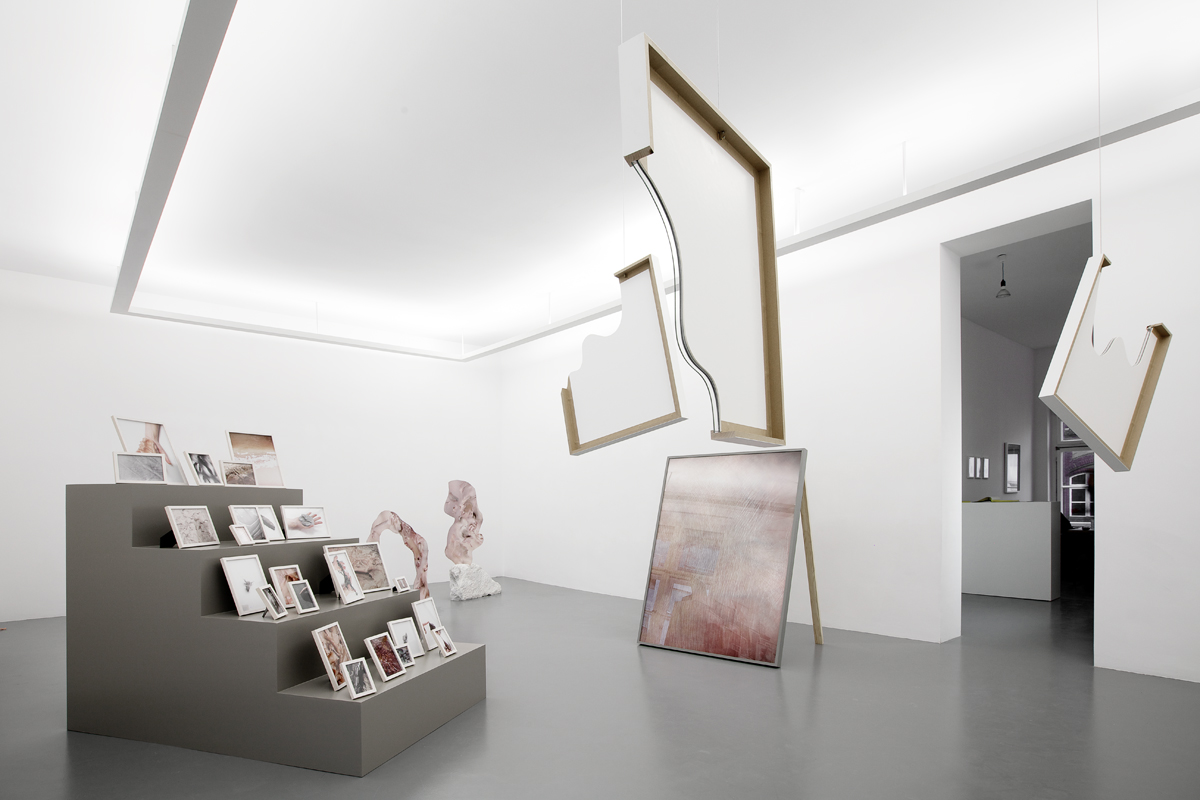 “The Molten Inner Core”, Installation View at Neumeister Bar-Am; Photograph courtesy of Neumeister Bar-Am
“The Molten Inner Core”, Installation View at Neumeister Bar-Am; Photograph courtesy of Neumeister Bar-Am
Berlin-based Rachel De Joode examines the world of things in her recent show The Molten Inner Core at Neumeister Bar-Am, and will collaborate with artist Kate Steciw in a shop-style performance and installation for Gallery Weekend in May.
Before an object, material, or idea is understood – before it has a name – language relegates it to being a ‘thing.’ Not until it is cut open, taken apart, appropriated, used or misused, do we begin to know it, and consequently title it appropriately, as needed. It is then that this thing can become ours to categorize and organize within our systems of knowledge.
Dutch-born, Berlin-based artist Rachel De Joode inverts this process in her study of “things,” and returns them back for refreshed and deconstructed viewing, wherein we once again feel unsure or almost suspicious about the objects with which we co-exist. In her most recent solo exhibition, The Molten Inner Core, on view until the 26th at Neumeister Bar-Am, Rachel continues to reassemble and decontextualize the common and the known, bringing into question their pre-assumed place within our symbolic systems and worlds of knowing.
De Joode presents an egalitarian cast of object-characters, from delicate clay forms on pedestals to a powerfully large standing photograph of skin. Each object appears as pure surface, allowing them to be free of any kind of definitive framework. De Joode breathes new questions into the phenomena of our environment and the way in which things are moulded and changed by the actions of our own hands: in this case, De Joode’s hands. Agency (25 Photographs of Things) pulls in reference to the Kodak family portrait collection, where photographs of dust stand alongside a photograph of a meteorite, nearby portraits of her own hand presenting moulded, dewy surfaces of ambiguous grey goo and clay. Asking for these items to be viewed for their connections to one another first, and then, but less immediately, to us, their imagined histories remain fluid and loose, as these framed materials liberally converse with one another. Meanwhile, the artist’s hand intervenes into these “portraits,” almost as a sideshow to these now central and animated materials.
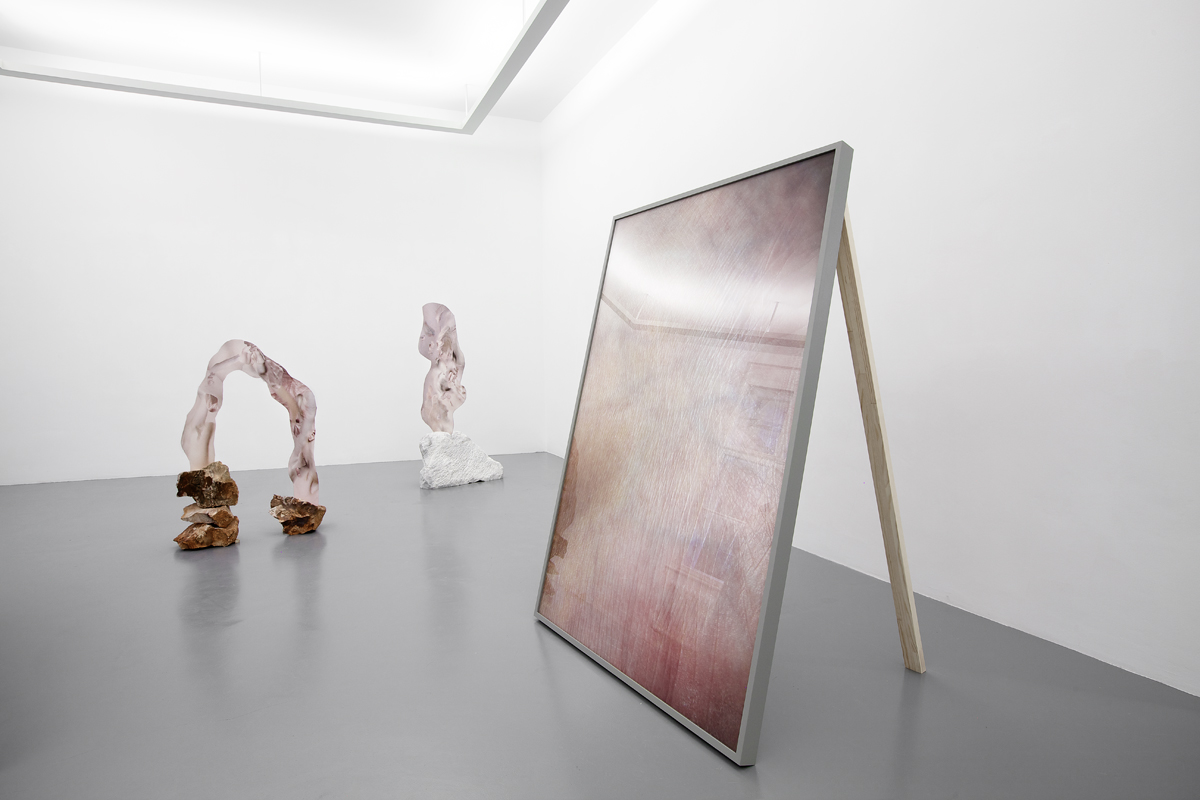 “The Molten Inner Core”, Installation View at Neumeister Bar-Am; Photograph courtesy of Neumeister Bar-Am
“The Molten Inner Core”, Installation View at Neumeister Bar-Am; Photograph courtesy of Neumeister Bar-Am
It is this kind of manipulation of object roles that connects this most recent show with the broader scope of De Joode’s photo work. Her dedication within her practice to the investigation of objects’ context and connotation is an outgrowth of her spanning body of work in photography and the ubiquitous still life, perhaps not coincidentally also a genre of Dutch mastery. That photography merges all-too seamlessly with the online sphere, standing on our screens against the white pixel background of art websites, is carefully considered in de Joode’s image and mixed-media work. Her photo-based sculptures speak to their coming, immaterial life on-screen, wherein art floats on and falls away into new spheres of symbolic definition. In Sculpted Human Skin in Rock (I & II) – a flesh-toned photo collage rising and falling from the sturdy foundations of marble – the illusory two-dimensional character of this ethereal pair brings a heightened awareness to the very setting of a gallery, the viewer’s presence within this semi-public space, and acts as a cautionary premonition for it’s soon-to-come life online.
With sensitive placement, these things transcend our human-centered vision of the world, of which language historically has played a dominant role in our process for understanding. Perhaps this is why each work is so simply titled with nothing more than a few descriptors, holding back any kind of suggestive bias or frame from which to learn about each thing.
What we come to realize by her process is that the world is less ours than we may imagine it ought to be, as her re-appropriation of objects and materials render each free to move away from stable definitions and human-imposed hierarchy. They return to wander within a loosely associated cosmos of materials, relating into new contexts together, irrespective of any knowledge or human-centered ontology we usually, often subconsciously, impart upon them.
With the upcoming Open for Business collaboration, the third manifestation of a project Rachel de Joode has been working on with U.S.-based artist Kate Steciw, De Joode merges her practice in a one day “pop-up shop” within Neumeister Bar-Am for Gallery Weekend (May 5th). As both a performance and installation project, Open for Business plays with the operative routines of the art market, as the two collaborate to complete a piece before the end of the relegated 10-6 workday. The two build on their common interest in photography as a generative practice and investigate questions surrounding ownership, production, industry, and the limitations and possibilities of image and information over time and space.
Understandably, De Joode has been busy with her “things,” but we managed to talk to her about just that.
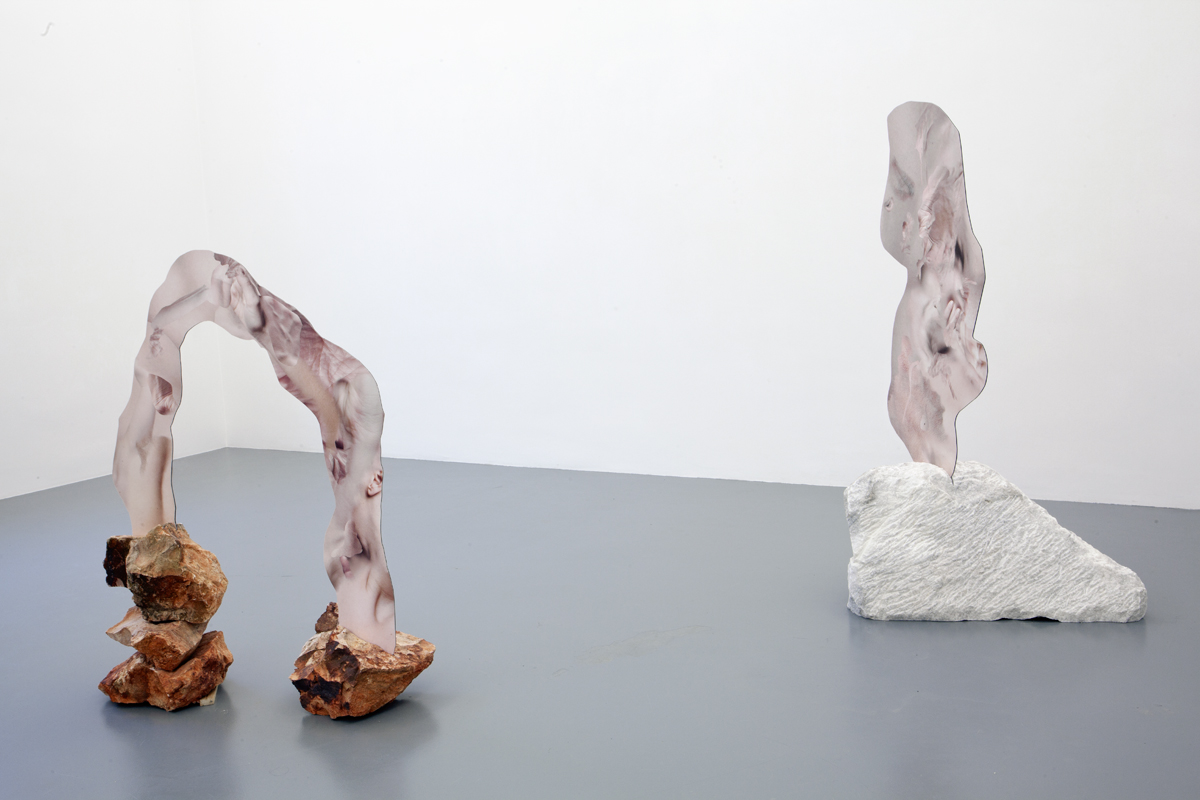 “The Molten Inner Core”, Installation View at Neumeister Bar-Am; Photograph courtesy of Neumeister Bar-Am
“The Molten Inner Core”, Installation View at Neumeister Bar-Am; Photograph courtesy of Neumeister Bar-Am
KATE BROWN: In The Molten Inner Core you continue with your exploration of ‘things.’ The word ‘thing’ is interesting to me – it’s a word we often apply to subject matter we don’t understand. In a way, it has a distancing affect. It functions in the opposite affect to something like a nickname. Would you agree? Etymologically-speaking, what does the word ‘thing’ mean in the context of your art practice?
RACHEL DE JOODE: Yes, the word ‘thing’ emphasizes a more alien approach/way of looking which I believe is very useful, both as an artist, but also as a human. An alien viewpoint helps to relativize human domination on planet earth, it helps to abstract human attributes.
To me the word ‘object’ implies too much materiality. I don’t condemn the word object, I just think there is an attractive looseness or flexibility to the word ‘thing.’ It seems to me to be a bit more playful.
On the whole, I guess to me the word ‘thing’ names everything that is not simply nothing.
KB: Your study of things incorporates human forms into a dialogue with dust, marble, clay, a dinosaur bone, reforming the usual hierarchical structures between some things and other things: our bodies and “the rest.” What motivates this?
RJ: It is my intention (from an object-oriented ontological viewpoint) to decenter the human from our very human existence on earth.
Recently, I read and was inspired by philosopher Ian Bogost’s book Alien Phenomenology, or, What It’s Like To Be a Thing, which (in very short) outlines a system of thought in which no object has precedence or hierarchy over another.
I like to see the work Agency (that you describe in your question) as a visual list of things; nonhuman and human (my skin). This visual list tries to point out the agencies that are at work while making an art-work, ie. an assemblage of things that are set in motion when me-the-artist is making an artwork. For example, the dust that resides in the corner of my studio while I am thinking of the work (the dust that I partly breathe in and that is also partly made of my dead skin-flakes). Or one hair that I left on my pillow the morning I wake up, or a thought about a dinosaur bone or a texture of some art-material or the itching of my foot-sole. By non-hierarchicaly pointing out a handful of things, or actors, that are all involved in the art-making process I try to reorient the human idea of art-making or the art-piece itself. I leave the (ta-da end result!) art-piece that is normally made and presented away and present its actors in a kind of family photo setting.
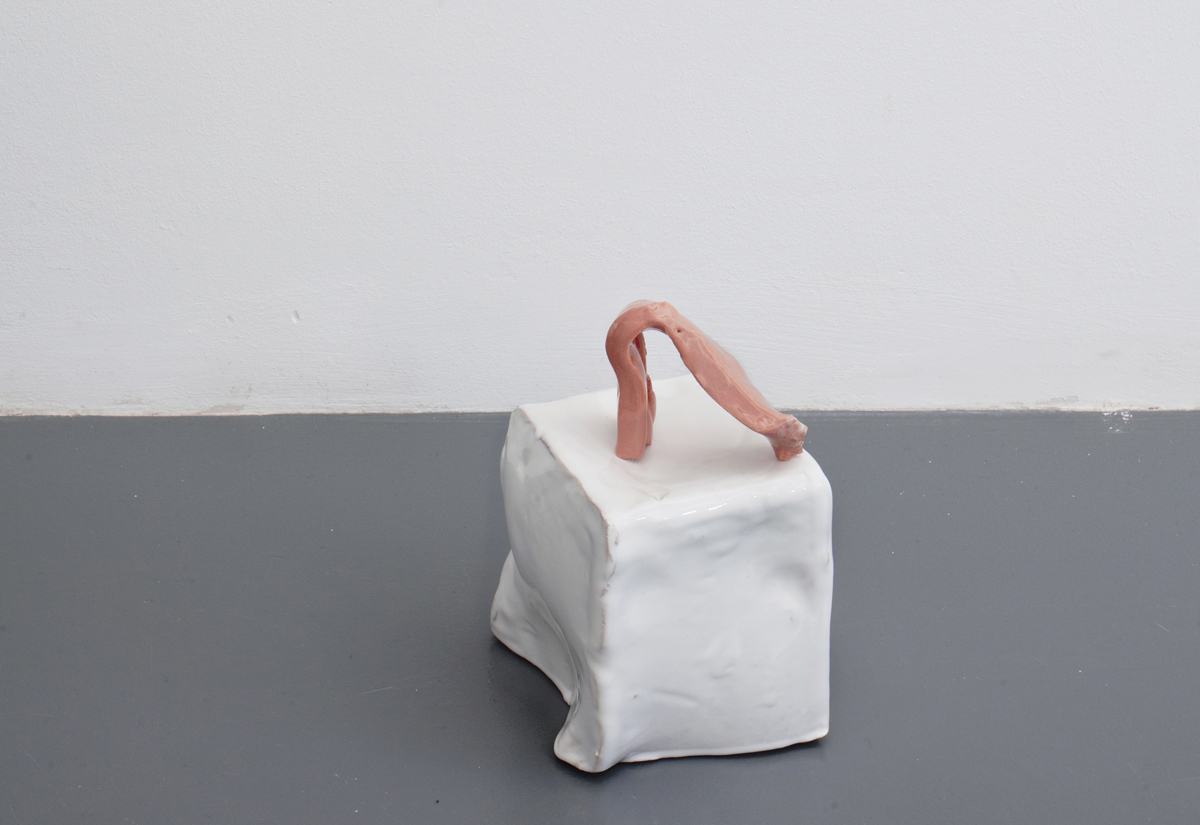 “White Pedestal Thing (I-V)” (2014), Installation View at Neumeister Bar-Am; Photograph courtesy of Neumeister Bar-Am
“White Pedestal Thing (I-V)” (2014), Installation View at Neumeister Bar-Am; Photograph courtesy of Neumeister Bar-Am
KB: What exactly is the molten inner core of an object?
RJ: I took the title from Object-Oriented philosopher Graham Harman. To him, objects have autonomy, and exist beyond the needs and desires of humans. Objects are not for us! He uses ‘The Molten Inner Core’ as a metaphor when answering the question: what is going on in the interior of an object?
Using the analogy of a tree and oneself as forming a unified object, Harman writes: “located inside the unified object that the tree and I form, it is the hollow, molten, inner core of objects where all intentional relation occurs”.
This tree/self metaphor leads us to, as Harman says, “Vicarious causation, of which science so far knows nothing, is closer to what is called formal cause. To say that formal cause operates vicariously means that forms do not touch one another directly, but somehow melt, fuse, and decompress in a shared common space from which all are partly absent. My claim is that two entities influence one another only by meeting on the interior of a third, where they exist side-by-side until something happens that allows them to interact. In this sense, the theory of vicarious causation is a theory of the molten inner core of objects – a sort of plate tectonics of ontology.”
I like this idea of the thing inside the unified object: the thing that one and the other object form together. In a way, making art is always about this unified space where the maker and the material fuse.
KB: You just completed research on meteorites. What made you interested in meteorites as a subject matter?
RJ: Last winter/spring I received a 2-month residency and funding (from the Deutsche Börse) to do research and to create a body of work. I was doing research in the Senckenberg Institute in Frankfurt, the residency was inside the Frankfurter Kunstverein.
Meteorites contain the oldest known rocks in our solar system. They also contain ‘pre-solar grains,’ which are minerals that formed around other stars probably billions of years before our solar system was born. I am fascinated by meteorites because they are these little bits of outer space that enter the earth surface and that show us our own alienishness and at the same time they connect us to the cosmos.
I mean, earth is as much outer space as any other planet is. We are part stardust, we are part meteorite, we are the same. We (planets, stars, meteorites, milky ways, black holes) are all existing in the universe, the cosmos.
Then the way meteorites look so humble is most compelling! Their sheer lack of affect, their silence, their sheer stoniness as, Roger Caillois puts it, makes the meteorite something mysteriously fascinating.
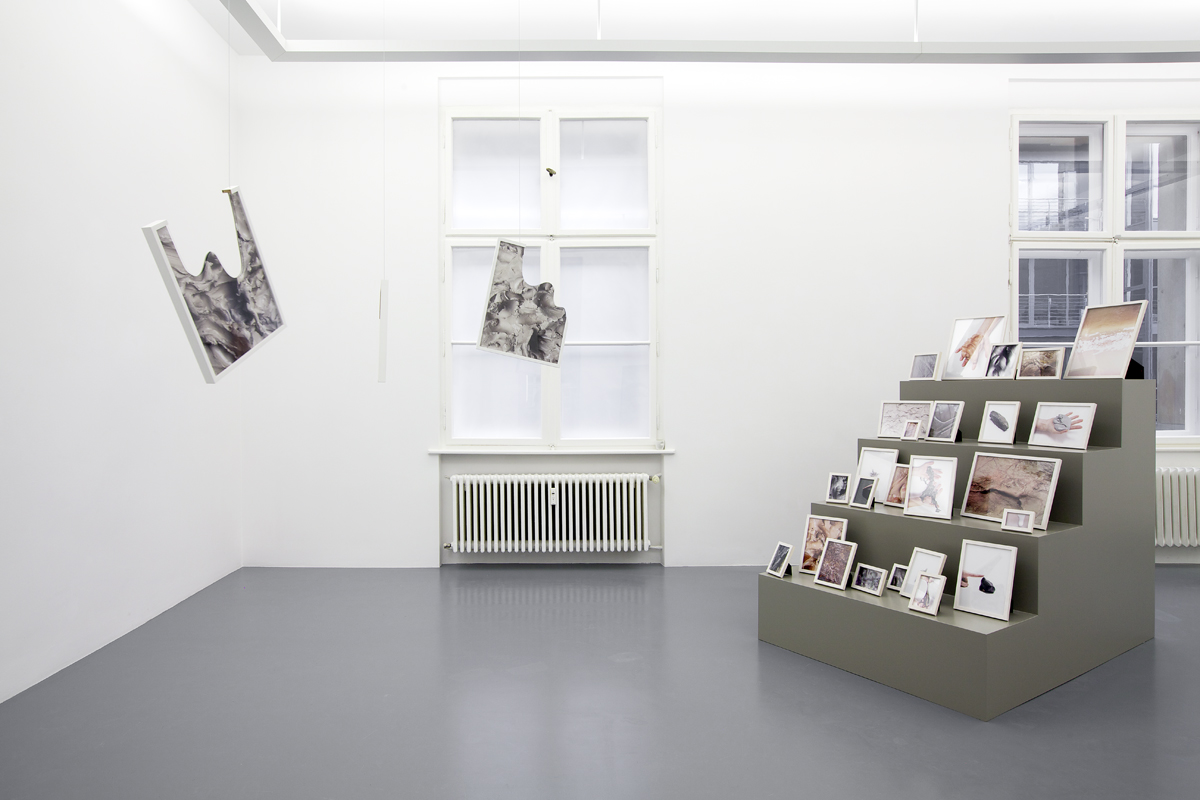 “The Molten Inner Core”, Installation View at Neumeister Bar-Am; Photograph courtesy of Neumeister Bar-Am
“The Molten Inner Core”, Installation View at Neumeister Bar-Am; Photograph courtesy of Neumeister Bar-Am
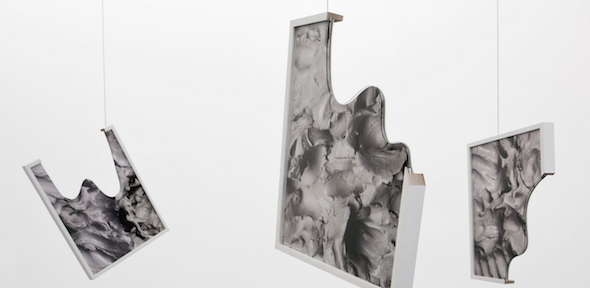 A Ruin (I, II & III), installation view at Neumeister Bar-Am; Photo courtesy of Neumeister Bar-Am
A Ruin (I, II & III), installation view at Neumeister Bar-Am; Photo courtesy of Neumeister Bar-Am
KB: Would you say that part of your art focuses on the art of documentation and art as a documented object?
RJ: Without wanting to be cynical, the end result of any contemporary exhibition is a jpg circulating the internet.
Yes, I am working a lot with the idea of art-documentation being the work and many of the works I made in the last year, such as Various Qualities To Orbit The Mysterious Core or the works in this show like Sculpted Human Skin In Rock, play with the in-real-life-ness of the white cube and its web-based installation-documenation. I work a lot with issues like 2-dimensionality versus 3-dimensionality, with proportions, with performativity of the work, with surface.
I think the article Flatland by Loney Abrams really pins it down:
“Far more people see art on screens than in museums. The gallery is no longer the primary exhibition space; the Internet is. As documentation—photographs or videos that capture a finished work of art, usually installed within a gallery—are posted to the Internet and then dispersed and multiplied via likes and shares, online viewers become the overwhelming majority of an exhibition’s audience. The digital image is supplanting the art object. All works, regardless of their material constituents, are flattened, scaled down to several hundred pixels. Consequently, the digital photographic image can be understood as the homogenizing, ubiquitous medium of our era.”
KB: How has the prevalence of the online art experience affected your work over the years?
RJ: In general the Internet has been very good to me, I have had the possibility to show my work to a large audience and I received a lot from it. Also, I have had the possibility to get to know artists and their work more so then I would ever be able to do when there would be no Internet. I love surfing the web looking at art and one artist/artworks leading to another artist/artwork. It inspires me a lot.
KB: What else can we look forward to from you in 2014?
RJ: I just accepted an adjunct professorship at a university in the U.S., I will be moving there (for two semesters, 9 months) with my then-born-child and husband, so this will be quite exciting! Also, I will be working on some curatorial projects the coming period.
And in the beginning of April I have a show in Naples at Museo Apparente and at the end of June I have a solo-show in Glasgow which is curated by itsourplayground at SWG3 Gallery.
And I am giving birth very soon. This is something which I am most excited about! A new human!
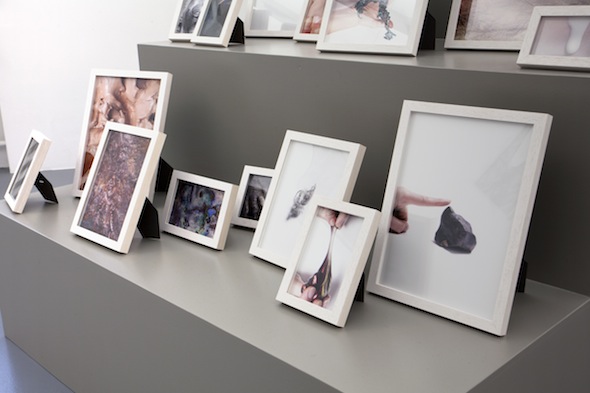 (Detail) “Agency (25 Photographs of Things)”, installation view at Neumeister Bar-Am; Photograph courtesy of Neumeister Bar-Am
(Detail) “Agency (25 Photographs of Things)”, installation view at Neumeister Bar-Am; Photograph courtesy of Neumeister Bar-Am
___________________________________________________________________________________
Additional Information
NEUMEISTER BAR-AM
“The Molten Inner Core” – RACHEL DE JOODE
Exhibition: Feb. 22 – Apr. 26, 2014
Goethestraße 2 (click here for map)
___________________________________________________________________________________




















